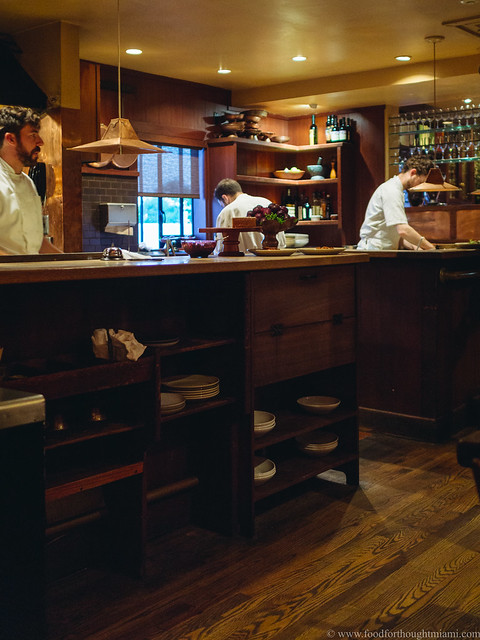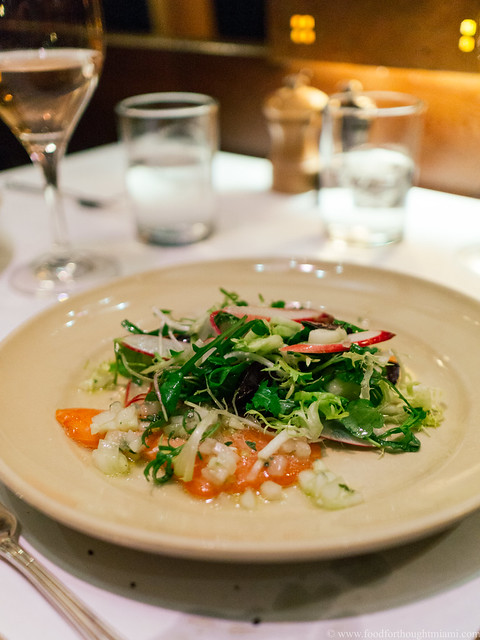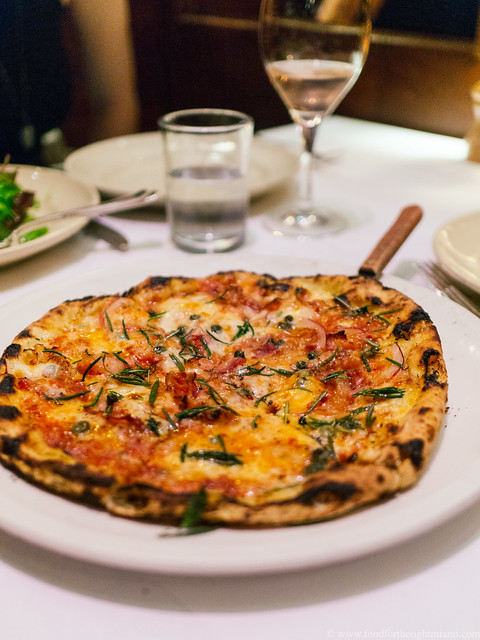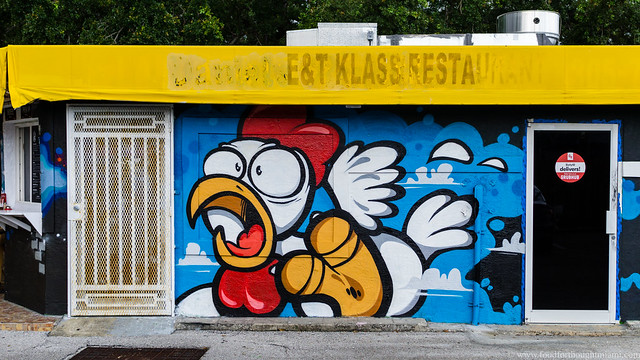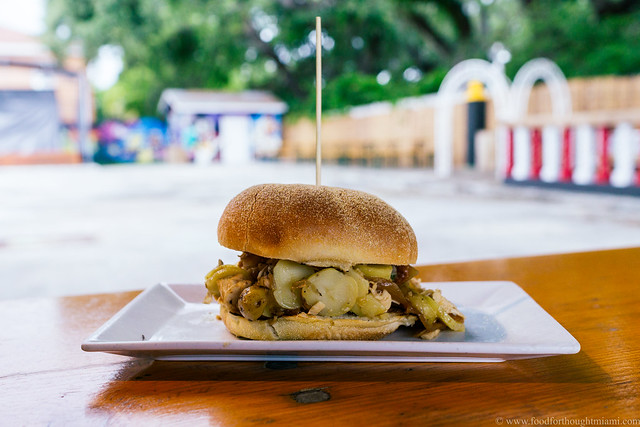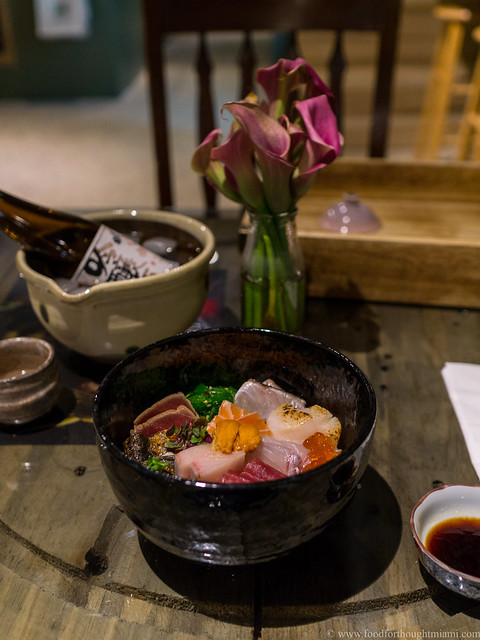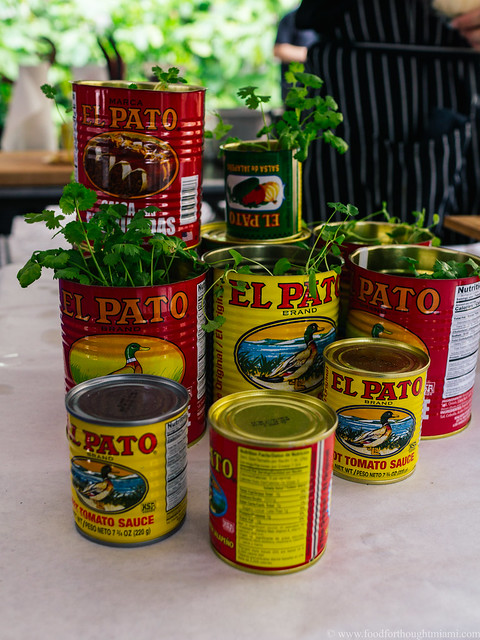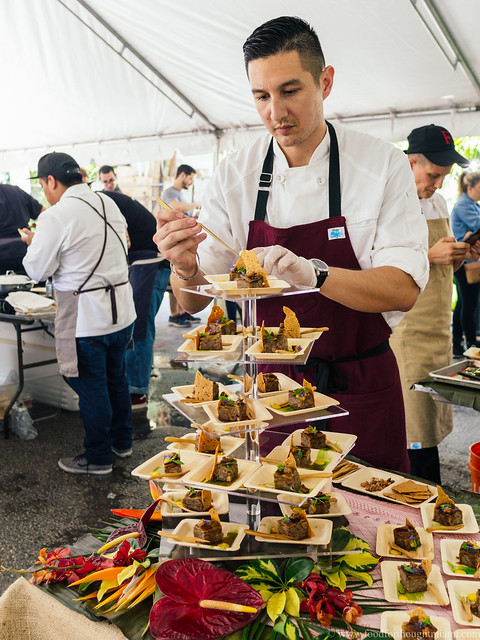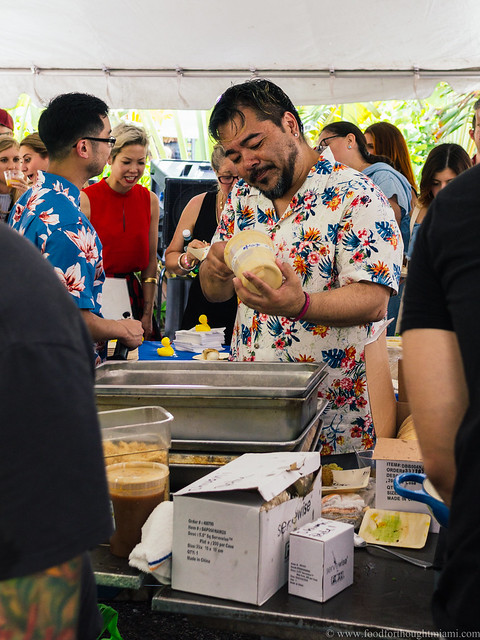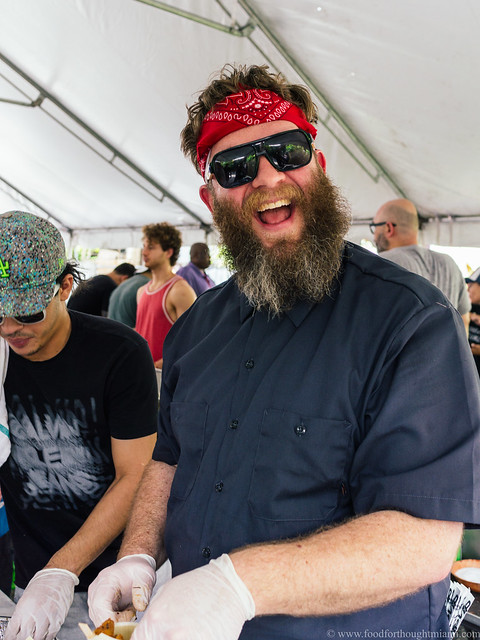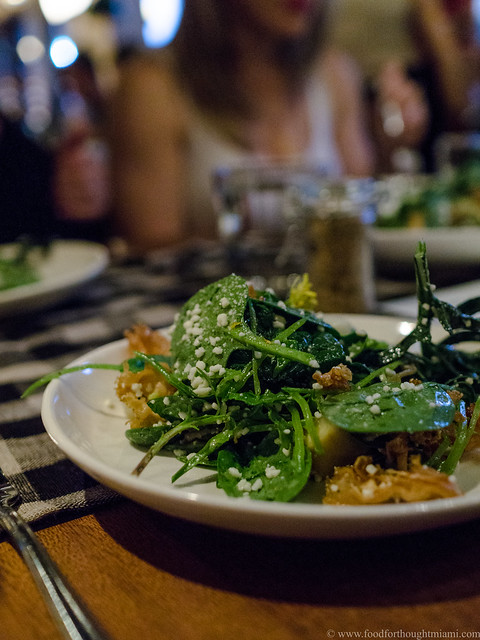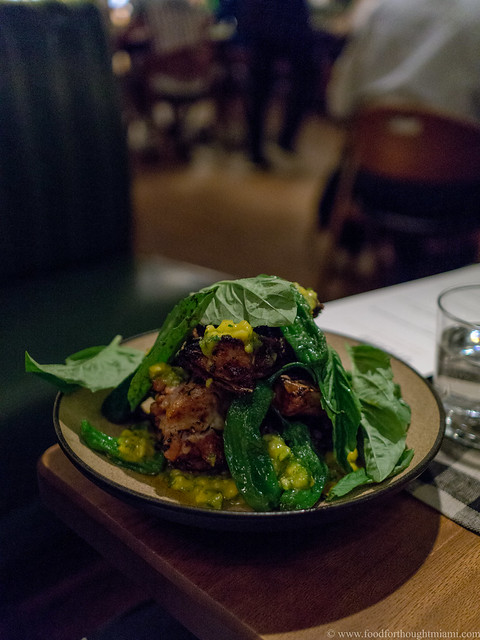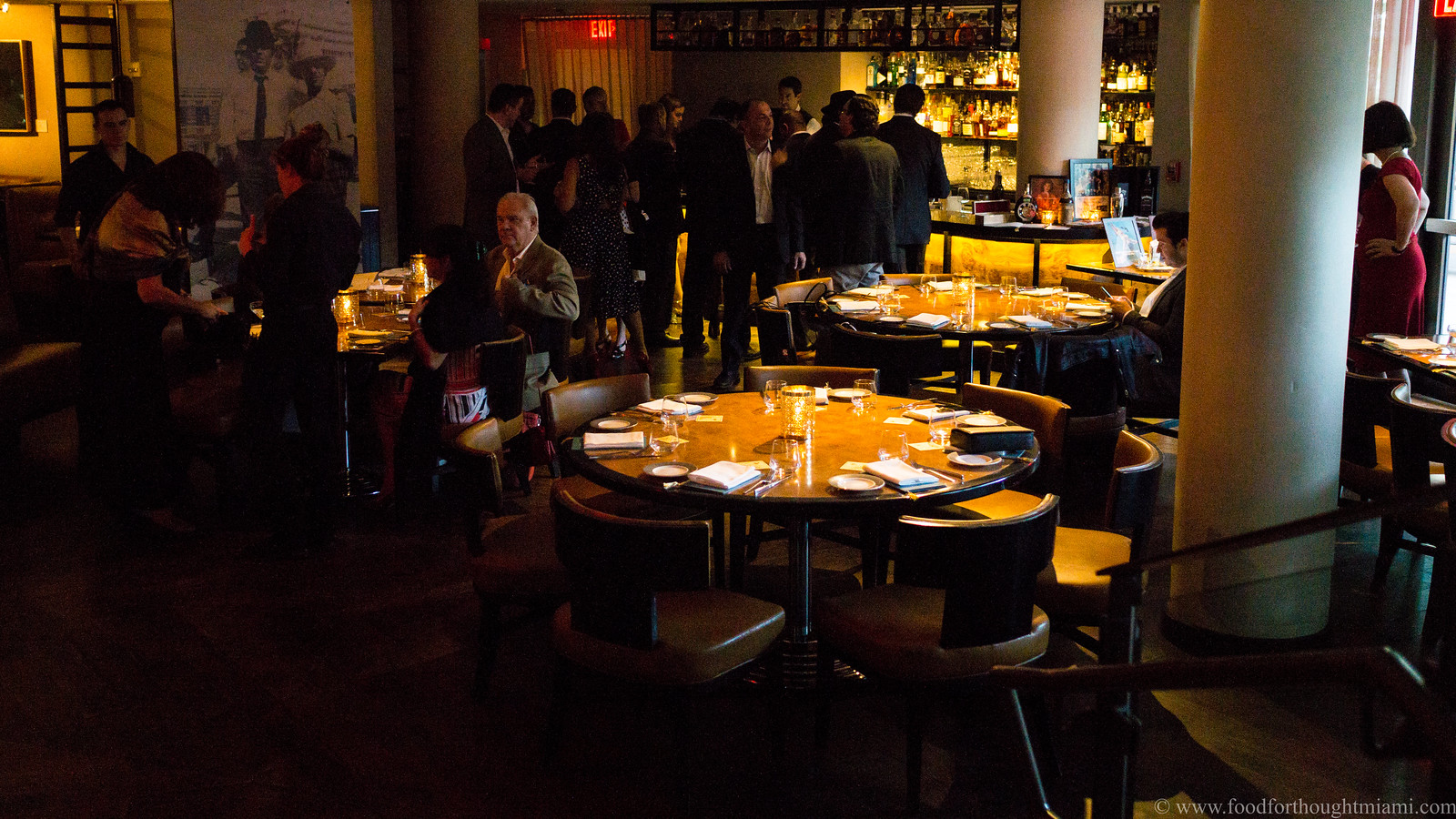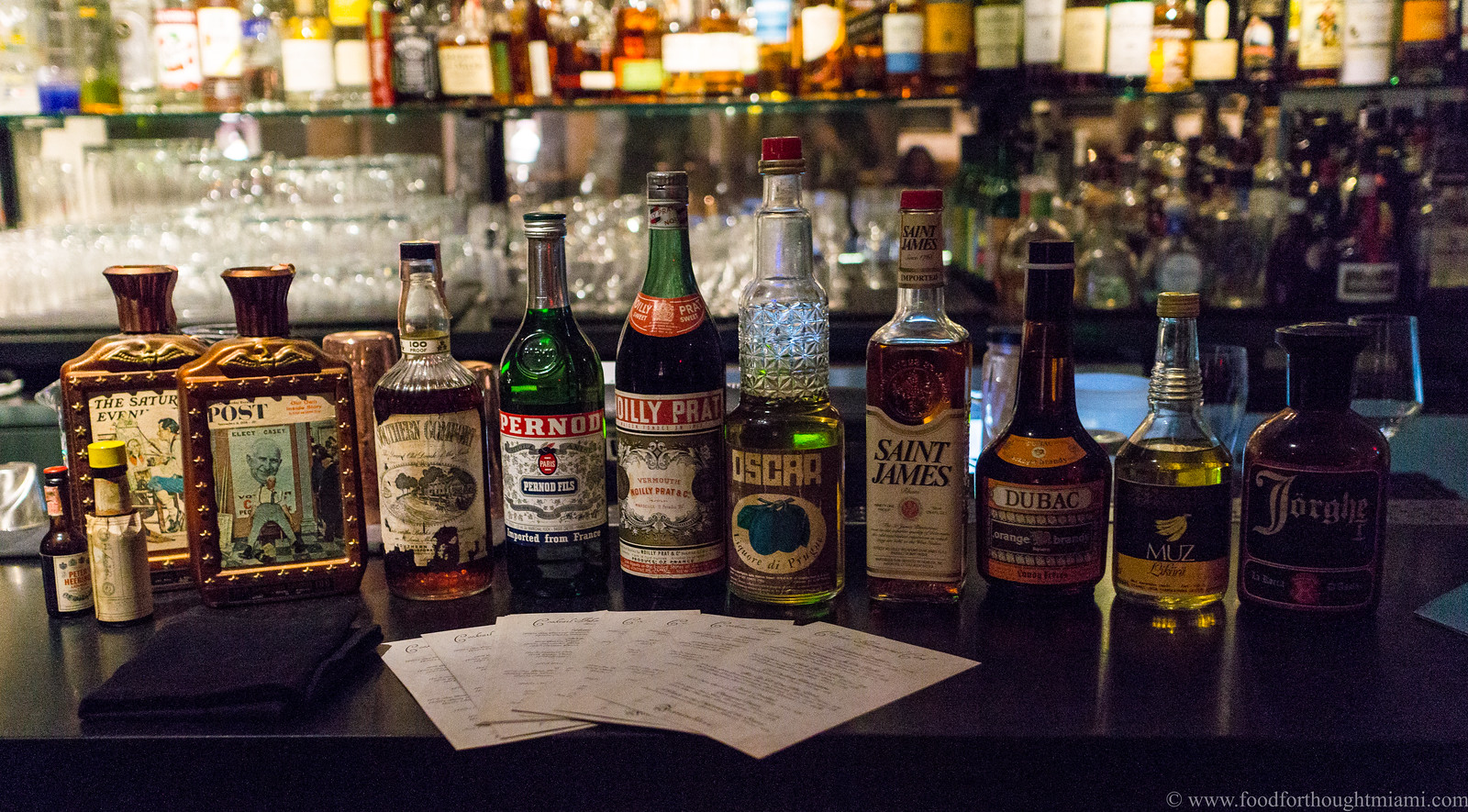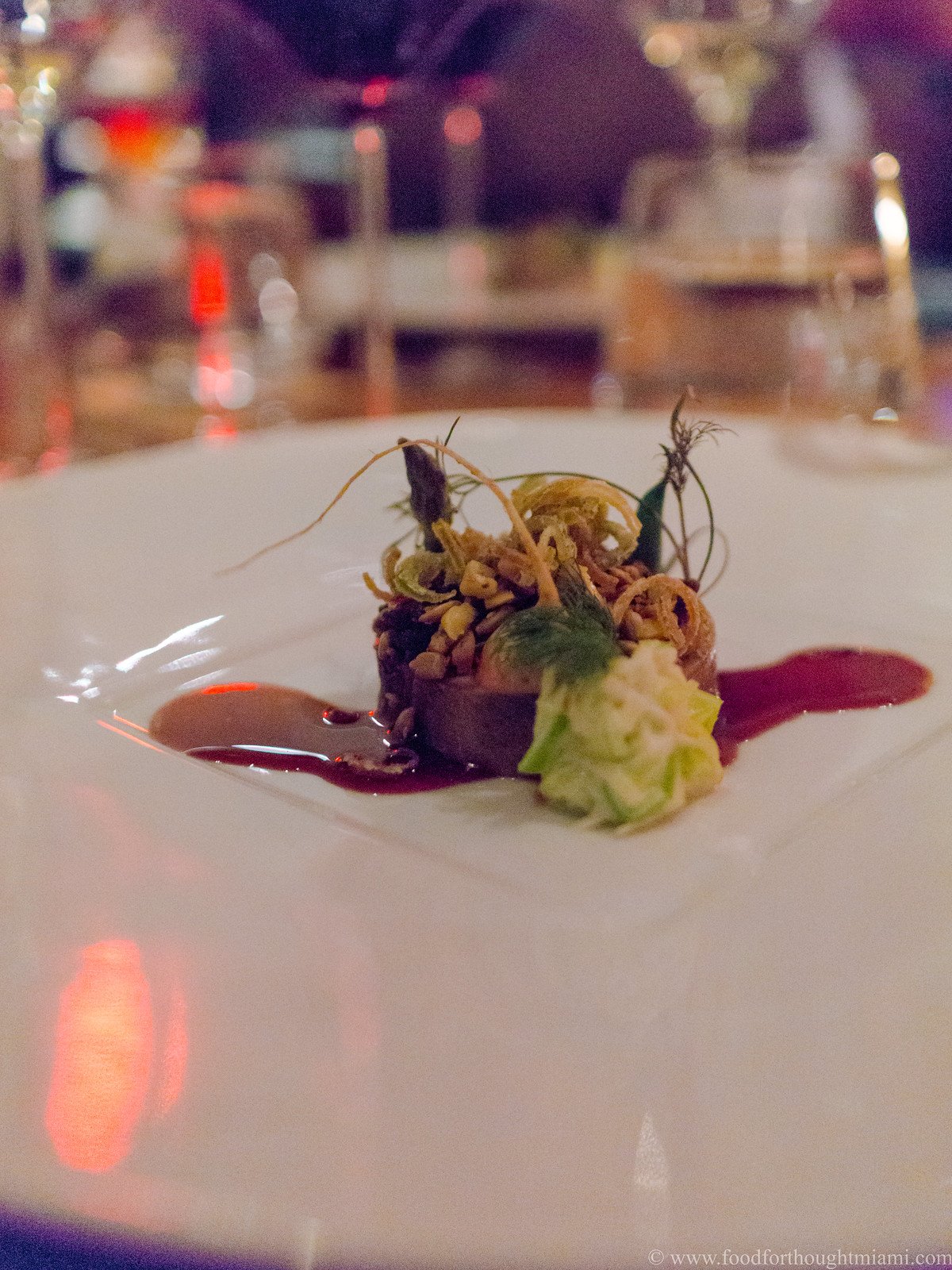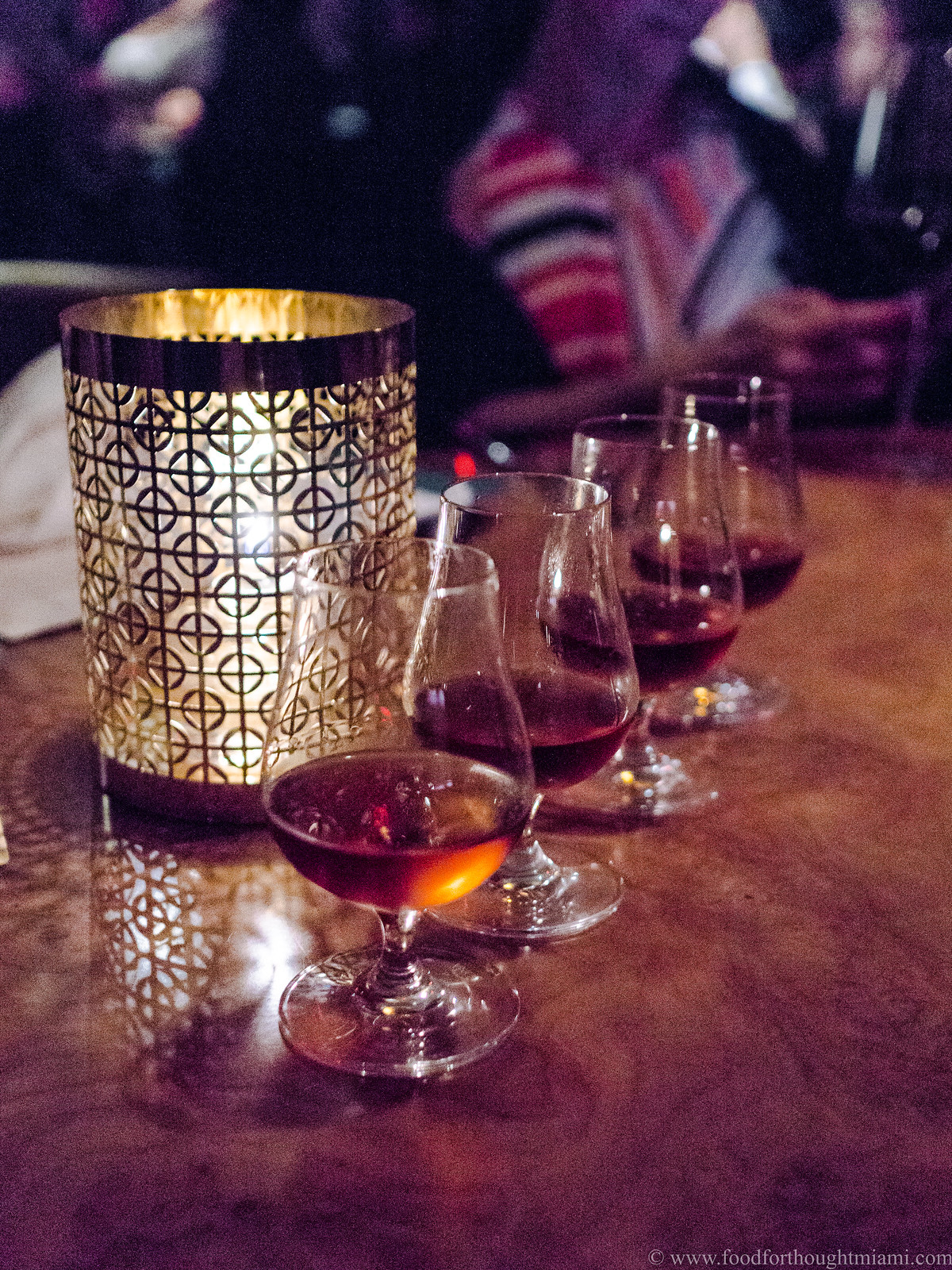Some places aren't just restaurants; they're institutions. Chez Panisse certainly falls in that category. Its founder, Alice Waters, is widely regarded as the patron saint of the "farm-to-table" movement: the restaurant, which she opened in 1971, made the sourcing of local ingredients a cornerstone long before that term was commonly used, much less beaten to death.[1] And generations of restaurants since have followed suit.
My last visit to Chez Panisse must have been about twenty years ago.[2] It doesn't seem to have changed much at all, even though the two-story Arts and Crafts style space got a major facelift about five years ago after a fire. (No doubt it helped that the architect who first designed the restaurant, Kip Mesirow, was responsible for the renovation as well.) Downstairs is the original "restaurant," which still serves a three- or four-course prix fixe menu in a sort of country French idiom that changes on a daily basis. Upstairs is the "café," opened in 1980, which offers an à la carte menu and a somewhat more casual feel. Maybe the biggest change is that both upstairs and downstairs now have open kitchens, whose wood cabinets and shelves blend so seamlessly into the rest of the space that it really does feel a bit like eating in someone's home.
(You can see all my pictures in this Chez Panisse flickr set.)
Remarkably for a restaurant that's been around for nearly half a century, Chez Panisse doesn't feel particularly dated. Indeed, aside from the farm-to-table thing, there are at least a couple other facets of contemporary dining culture where I think Chez Panisse was way ahead of the game, including those daily changing menus, and the combination of high-end food in a more informal setting. If I told you that a rustic-looking place, with a charcoal grill and wood burning oven, serving food straight from the farms, fields and docks had just opened in the East Bay, you'd probably think it was right on trend. It's a testament to the restaurant's outsize influence; and, I suppose some would say, to the stagnancy of what's come to be known as "California Cuisine."[3]
There's a reason for the genre's staying power, though: when it's done right, it's still very good, especially in Northern California, which produces some of the greatest raw ingredients on the planet. And Chez Panisse is still doing it right.
We opted for the café over the restaurant. Although it may lack the dinner party vibe downstairs, the food still captures that "of the moment" feel: while the format of the à la carte menu stays largely the same, the particular pieces change from day to day, and sometimes even from lunch service to dinner.
Some of the highlights from our visit:
A simple salad of crisp, perky gem lettuce, dotted with juicy, sweet sungold tomatoes, napped with an assertively salty, funky anchovy dressing.
A crudo of wild California king salmon with cucumbers and green coriander, accompanied by a wispy salad of greens, herbs and slivered radishes.
A pizzetta cooked in the wood oven, topped with pancetta, hot peppers, capers and fresh rosemary – great to order as an appetizer "for the table."
(continued ...)
Monday, July 9, 2018
Wednesday, June 20, 2018
first thoughts: Sixty10 Organic Rotisserie Chicken | Little Haiti (Miami)
In the kitchen, unitaskers are anathema. All those avocado slicers and egg peelers and meat shredders just do the same things you can do with standard kitchen tools while taking up extra space in your drawers. As Alton Brown used to say on Good Eats, "The only unitasker allowed in my kitchen is a fire extinguisher."
When it comes to restaurants, though, I'm a big fan of unitaskers. Focus on just one thing, and you're more likely to do it well. Case in point: Sixty10 Organic Rotisserie Chicken, recently opened in Little Haiti. There are several items on the menu at Sixty10, but they are all essentially variations on one theme: chicken, rubbed with salt and spices, and cooked on a rotisserie until its skin is well-bronzed and its flesh pulls apart in soft, juicy ribbons. It may come as a whole, half or quarter chicken, along with a few different sandwich or salad iterations, but it's all about the bird. And happily, it's a really tasty bird.
(You can see all my pictures in this Sixty10 flickr set).
On a first-time lunch visit last week, I got the Sixty10 sandwich: pulled rotisserie chicken meat, a tangle of caramelized onions, coins of fingerling potatoes slippery with chicken jus, all smooshed inside a kaiser roll It was simple, straightforward, and delicious. The seasonings are subtle, not overpowering; it tastes like chicken, but actually like chicken, not just a bland blank canvas. Having said that, a smear of mustard or a daub of hot sauce would probably do it wonders.
I'll have to make a return visit to bring a whole roasted chicken home for the family, which can be had with two sides (options include those roasted potatoes, a creamy, tangy cole slaw, brussel sprouts or green beans) and two sauces (could be jalapeño jam, curry sauce, or pikliz, a nod to the Little Haiti neighborhood, among others) for $34. That's about 50% more than you'd pay for a commodity chicken family meal at Pollo Tropical and it's probably about 200% better.
There's not much to the place right now, which used to be a Haitian Creole take-out joint: a window into the kitchen where you place your order, a covered patio with some tables and benches if you want to "dine in." But there's a huge, sprawling yard out back, partly shaded by live oaks spreading their branches over from the neighboring property, and the owners have bigger long-term plans: live music (a stage is already set up), a chickee hut (plans have been filed with the city), wine and beer in a picnic-style atmosphere (there's no liquor license yet, so for now they're sometimes pouring wine for free).
(continued ...)
Friday, June 15, 2018
Wabi Sabi by Shuji | Upper East Side (Miami)
My first taste of chef Shuji Hiyakawa's food came at an event last spring hosted by the Japanese Consulate in Miami, described as "Culinary Secrets of Traditional Washoku." "Washoku" literally means "Japanese food," but more specifically, the traditional cuisine of Japan (here's a good primer). After breaking down a whole tuna loin and making sushi of it, Chef Shuji also served a variety of other less heralded Japanese items: a seasonal dish of hotaru ika (firefly squid) with fresh bamboo shoots, yu choy in dashi broth with bonito flakes, sweet soy-braised root vegetables.
At the time, Chef Shuji, who made his way from Fukuoka, Japan to Miami by way of Philadelphia, where he had worked for several years as executive sushi chef for Morimoto, was weeks away from opening his own restaurant, Dashi. I went to Dashi shortly after it opened (you can read my first thoughts) and came away pretty impressed, albeit dismayed by the absence of a conventional sushi bar. But Dashi closed only a few months later after Hurricane Irma caused extensive damage to the River Yacht Club, where the restaurant was situated.
Fortunately, Chef Shuji had a back-up plan. Turns out he was already at work on another concept in a different space – and even better (for me, anyway), it was right along the path of my daily commute, in Miami's "Upper East Side" on N.E. 79th Street just over the Causeway from Miami Beach. In early January, Wabi Sabi by Shuji opened.
(You can see all my pictures in this Wabi Sabi by Shuji flickr set).
It's a simple but striking space, built out and decorated almost entirely by Chef Shuji himself. Across one wall sprawls a flock of multi-colored origami cranes. A table underneath is laid out with enough beautiful Japanese ceramics to serve a feast for about ten people (more on that later). Hanging from the ceiling and resting on counters are an abundance of kokedama moss ball planters. A few rough wood tables provide seating for maybe a dozen diners. At the back, there's a small kitchen island where you'll find Chef Shuji and assistant chef Maggie Hyams working away, and on some days, marketing and event coordinator Koko Makoto working the register, serving as hostess, and doing everything else that needs doing with grace and charm.
There's still no sushi bar. Rather, the idea of Wabi Sabi combines some Japanese tradition with the latest in American fast-casual trends: food in bowls. We all love food in bowls these days. Buddha bowls, poke bowls, power bowls, acai bowls – seems we'll eat anything if you put it in a bowl.[1] While some food trends are just plain stupid, this is one I can get behind: it's convenient, it's right-sized portioning, and when you put nice things in the bowl, it can be both delicious and aesthetically pleasing.
Which are also some of the things I love about Wabi Sabi. The menu at Wabi Sabi is straightforward: a choice of four different combinations of raw fish and accompaniments, over a choice of four different bases (sushi rice, a multigrain mixture, green tea soba noodles, or salad greens), with a choice of four different sauces – served in a bowl.[2] Any of the basic configurations will run you between $11 (for a vegetarian version which includes cucumber, avocado, scallion, seaweed salad, soy-marinated shiitake mushrooms, carrots and radishes) and $18 (for a fully decked out version with tuna, salmon, lump crab, tobiko, and an assortment of vegetables).
Or, for the ballers out there, there's also an "omakase" bowl, which features an ever-changing assortment of fish and seafood, much of it flown in straight from Tsukiji Market in Japan, served chirashi style over seasoned rice. That may mean blocks of fatty hamachi (yellotwail), ribbons of silky, clean kinmedai (golden-eye snapper), shimmering sayori (half-beak), creamy uni (sea urchin), silver-skinned aji (horse mackerel), house-cured iwashi (sardine) or kohada (gizzard shad), baubles of ikura (salmon roe), or any number of other possibilities, served over a bowl of seasoned rice, with seaweed salad, maybe some sprouts, maybe some soy-cured shiitake mushrooms, and a scatter of shredded nori batons.
Unlike the standard menu options, the omakase bowl is not cheap – pricing usually runs between $35 and $40, depending on what ingredients are featured that particular day. But if you add up what you would pay for a comparable sashimi or sushi order at any good sushi-ya – and the quality of the ingredients at Wabi Sabi is on par with what you'll find at the few places in Miami that fit that description – I think you'll find it to be roughly equivalent. It is also probably the easiest, most convenient way to eat some great sushi that you'll find in Miami, one that you can even take home and eat in front of the TV if you wish.
(continued ...)
At the time, Chef Shuji, who made his way from Fukuoka, Japan to Miami by way of Philadelphia, where he had worked for several years as executive sushi chef for Morimoto, was weeks away from opening his own restaurant, Dashi. I went to Dashi shortly after it opened (you can read my first thoughts) and came away pretty impressed, albeit dismayed by the absence of a conventional sushi bar. But Dashi closed only a few months later after Hurricane Irma caused extensive damage to the River Yacht Club, where the restaurant was situated.
Fortunately, Chef Shuji had a back-up plan. Turns out he was already at work on another concept in a different space – and even better (for me, anyway), it was right along the path of my daily commute, in Miami's "Upper East Side" on N.E. 79th Street just over the Causeway from Miami Beach. In early January, Wabi Sabi by Shuji opened.
(You can see all my pictures in this Wabi Sabi by Shuji flickr set).
It's a simple but striking space, built out and decorated almost entirely by Chef Shuji himself. Across one wall sprawls a flock of multi-colored origami cranes. A table underneath is laid out with enough beautiful Japanese ceramics to serve a feast for about ten people (more on that later). Hanging from the ceiling and resting on counters are an abundance of kokedama moss ball planters. A few rough wood tables provide seating for maybe a dozen diners. At the back, there's a small kitchen island where you'll find Chef Shuji and assistant chef Maggie Hyams working away, and on some days, marketing and event coordinator Koko Makoto working the register, serving as hostess, and doing everything else that needs doing with grace and charm.
There's still no sushi bar. Rather, the idea of Wabi Sabi combines some Japanese tradition with the latest in American fast-casual trends: food in bowls. We all love food in bowls these days. Buddha bowls, poke bowls, power bowls, acai bowls – seems we'll eat anything if you put it in a bowl.[1] While some food trends are just plain stupid, this is one I can get behind: it's convenient, it's right-sized portioning, and when you put nice things in the bowl, it can be both delicious and aesthetically pleasing.
Which are also some of the things I love about Wabi Sabi. The menu at Wabi Sabi is straightforward: a choice of four different combinations of raw fish and accompaniments, over a choice of four different bases (sushi rice, a multigrain mixture, green tea soba noodles, or salad greens), with a choice of four different sauces – served in a bowl.[2] Any of the basic configurations will run you between $11 (for a vegetarian version which includes cucumber, avocado, scallion, seaweed salad, soy-marinated shiitake mushrooms, carrots and radishes) and $18 (for a fully decked out version with tuna, salmon, lump crab, tobiko, and an assortment of vegetables).
Or, for the ballers out there, there's also an "omakase" bowl, which features an ever-changing assortment of fish and seafood, much of it flown in straight from Tsukiji Market in Japan, served chirashi style over seasoned rice. That may mean blocks of fatty hamachi (yellotwail), ribbons of silky, clean kinmedai (golden-eye snapper), shimmering sayori (half-beak), creamy uni (sea urchin), silver-skinned aji (horse mackerel), house-cured iwashi (sardine) or kohada (gizzard shad), baubles of ikura (salmon roe), or any number of other possibilities, served over a bowl of seasoned rice, with seaweed salad, maybe some sprouts, maybe some soy-cured shiitake mushrooms, and a scatter of shredded nori batons.
Unlike the standard menu options, the omakase bowl is not cheap – pricing usually runs between $35 and $40, depending on what ingredients are featured that particular day. But if you add up what you would pay for a comparable sashimi or sushi order at any good sushi-ya – and the quality of the ingredients at Wabi Sabi is on par with what you'll find at the few places in Miami that fit that description – I think you'll find it to be roughly equivalent. It is also probably the easiest, most convenient way to eat some great sushi that you'll find in Miami, one that you can even take home and eat in front of the TV if you wish.
(continued ...)
Monday, May 28, 2018
Duck Duck Goose Trois at The Anderson
I've said here often that P.I.G. - Pork Is Good, Jeremiah Bullfrog's locally grown celebration of all things porcine, has become my favorite Miami food event. A few years ago he added a spin-off – Duck Duck Goose, starring the one protein that may come close to rivaling pork's range, versatility and deliciousness: duck. The inaugural DDG in 2016 was a blast, but I sadly missed Number 2. The birds were back for Duck Duck Goose Trois this past Sunday afternoon.
(You can see all my pictures in this Duck Duck Goose Trois flickr set.)
It didn't look like good flying weather for ducks Sunday morning, with Subtropical Storm Alberto creating a wet and windy maelstrom. But somehow, like the eye of the storm, a perfect little window of calm, sunny weather opened up at just the right time. The festivities, hosted by The Anderson bar on Miami's Upper East Side, went off without a hitch. Here are some highlights:
Duck terrine with a wild mushroom gelée, pickled sunchokes, smoked duck egg yolk and duck chicharrones from David Coupe and Josue Peña of Faena. Really beautiful technique and great flavors.
Torched miso and duck fat onigiri stuffed with miso seasoned slow cooked duck, from Katsuya Fukushima of Washington DC's Daikaya – very possibly my favorite bite of the day.
Fuqi Feipian – literallly "husband and wife lung" – done here as crispy tripe and confit duck wings laced with Szechuan chili oil from Jeremiah Bullfrog. A close rival for my favorite bite of the day, given my penchant for tripe.
(continued ...)
(You can see all my pictures in this Duck Duck Goose Trois flickr set.)
It didn't look like good flying weather for ducks Sunday morning, with Subtropical Storm Alberto creating a wet and windy maelstrom. But somehow, like the eye of the storm, a perfect little window of calm, sunny weather opened up at just the right time. The festivities, hosted by The Anderson bar on Miami's Upper East Side, went off without a hitch. Here are some highlights:
Duck terrine with a wild mushroom gelée, pickled sunchokes, smoked duck egg yolk and duck chicharrones from David Coupe and Josue Peña of Faena. Really beautiful technique and great flavors.
Torched miso and duck fat onigiri stuffed with miso seasoned slow cooked duck, from Katsuya Fukushima of Washington DC's Daikaya – very possibly my favorite bite of the day.
Fuqi Feipian – literallly "husband and wife lung" – done here as crispy tripe and confit duck wings laced with Szechuan chili oil from Jeremiah Bullfrog. A close rival for my favorite bite of the day, given my penchant for tripe.
(continued ...)
Wednesday, April 4, 2018
Cobaya Upland with Justin Smillie
When I first heard that Upland was opening in Miami Beach, the place was something of an enigma to me. I thought of Justin Smillie as a New York City chef (one whose NYC restaurant, also named Upland, I'd never tried), but the menu felt like it came from the other coast. As it turns out, Upland is a town in San Bernardino County inland of Los Angeles where Smillie was born, and his cooking style is indeed very much inspired by the "California cuisine" idiom: seasonal, vegetable forward, casual in presentation but still precise in execution.
The South of Fifth spot, which Smillie opened with restaurateur Stephen Starr (whose Miami products also include Makoto and Le Zoo) has become one of my favorites among the latest crop of "Sixth Borough" restaurants in Miami. I love the dining room, designed by Roman & Williams, with its green leather banquettes and walls lined with backlit jars of preserved lemons. But even more, I love the food, whose superficial simplicity usually belies a sonorous depth of flavor.
We were eager to do a Cobaya dinner with him, and the interest was mutual, but since Smillie is not in South Florida regularly this was a challenging one to schedule. We finally lined up a date, and even though it was only a week after our last event, we jumped on the opportunity.
As always, our request to the chef was simple: do whatever you want, just don't do anything on your regular menu. Smillie's response was entirely off-menu, but also entirely in keeping with the spirit of his restaurant.[1] Here's what he made:
(You can see all my pictures in this Cobaya Upland with Chef Justin Smillie flickr set).
Smillie started things off with a salad – served family style – and my immediate reaction was, "It's not going to be as good as his little gem salad," a combination of perky gem lettuce, avocado, cucumber, and shaved ricotta salata in a walnut vinaigrette that hits all the right notes for me. I was wrong. This was every bit its equal. Here were all sorts of early spring things: tender spinach leaves, asparagus, fava beans, artichokes, frilly little mushrooms that were crispy like croutons. Crumbled cotija cheese added some creamy richness, a precisely balanced vinaigrette added structure and brightness.
Mrs. F thinks I hate salads. I don't. A good salad makes me very happy, and this was a very good salad.[2]
Spring is also the season for soft shell crabs, when they molt from their hard exoskeletons and basically the whole critter can be eaten. Smillie gave these a crispy new shell of flaked coconut, and served them with a hemp seed aioli and a bouquet of fresh soft herbs. There was a sneaky bit of nostalgia here which it took me a while to pinpoint: this was like a gussied up version of coconut shrimp!
Speaking of nostalgia – when was the last time you had mango salsa? When was the last time you actually saw mango salsa on a menu, even here in the erstwhile capital of Mango Salsaville? Smillie described this dish as "hot smoked tuna cheek, spicy mango," but let's call that "spicy mango" what it is: MANGO SALSA! And it was delicious! The smoked tuna cheek, like the Japanese izakaya staple hamachi kama (yellowtail collar), was somewhat fiddly and took some work to extract the good bits, but the reward was some of the fattiest, most unctuous, flavorful flesh on the fish. And yes, it tasted great with the sweet and heat of that "spicy mango," as well as the blistered shishito peppers and huge basil leaves draped on top.
If the Miami Heat can break out some neon pink and blue Miami Vice uniforms this year, it's only fitting we bring back mango salsa too.
(continued ...)
Sunday, March 25, 2018
Cobaya Time Machine at Stripsteak with William Crandall and Seth Weinberg
There were no paintings of poodles, but just about everything else from our Cobaya dinner at Stripsteak a couple weeks ago hearkened back to the era of the Poodle Room, a cozy bar from the opening days of the Fontainebleau resort. Designed by architect Morris Lapidus and completed in 1954, the Fontainebleau was maybe the most ostentatious example of the grand but playful "Miami Modern" style, and quickly became a popular playground for the rich and famous. Frank Sinatra and the "Rat Pack" hung out here. Elvis performed here after he returned from military service. Movies were filmed here, including Jerry Lewis' "The Bellboy" and scenes from "Goldfinger" My in-laws (neither rich nor famous, but long-time Miami Beach denizens) used to go see shows at La Ronde nightclub."Abandon care and enter light-hearted ...for this is the Poodle Room, the exquisite tongue-in-cheek room,and here life is never quite serious! Lift your cocktailsin an atmosphere reminiscent of an intimate salon in a French palace ...its damask decor a background for paintings of poodleswith an amusing resemblance to Fragonard's playful courtiers and ladies."
With all that history to play with, Stripsteak chef William Crandall and bar director Seth Weinberg went with a "Time Machine" theme for our dinner. They found postcards, matchbooks and swizzle sticks from the hotel's first days, scoured old menus for historical dishes, and maybe most remarkably, sourced spirits all from the 1950's through 1970's for cocktail pairings to go with the dinner. It was a pretty remarkable and fully realized experience.
You can see all my pictures in this Cobaya Fontainebleau 1954 flickr set. Here's a rundown of the evening.
Once our guests arrived, they were offered a Hemingway Daiquiri made with 1970's era Bacardi Superior rum and 1950's era Cherry Heering, along with grapefruit juice and lime. Then they were shown downstairs to the "Poodle Room" – a corner of the Stripsteak dining room conveniently situated next to the bar.
That bar counter was lined with spirits that were anywhere between forty and sixty years old, some recognizable – Southern Comfort, Pernod, Noilly Prat Vermouth – and some rather mysterious – Oscar Liquore di Prugne?
Chef Crandall had dug through old menus from the Fontainebleau to look for inspiration, and his lineup featured dishes that you very well may have eaten at the hotel's restaurants way back when, but prepared with modern cooking sensibilities. A disk of creamy, rich foie gras torchon came dappled with a peppered port wine sauce and a quenelle of soft, melted julienned leeks, very old school, but also a crispy pumpernickel crumble in place of the traditional toast points. With this, Seth poured something he called "Strangers in the Night," a sweet-leaning concoction of Barres Colheito Porto from 1979, 1950's Stravecchio Branca (an oak-aged Italian brandy), and 1957 Chateau Thierry orange bitters.
I thought it was smart that they didn't quite try to serve each cocktail with a particular dish, but instead would often serve them between courses, as the strong flavors could easily overwhelm more delicate dishes. This was especially so because Seth took his "Time Machine" mission pretty literally: than the citrus in the opening daiquiri, literally everything in the other cocktails came from another era. This made for some very spirit-forward drinks, which is how I usually like them, but can be a tough match with food. For the next round, and sticking with the Sinatra theme, there was a drink he called "Luck Be a Lady" –1962 Southern Comfort (higher proof and less sweet than the current version), 1972 Dubac Orange Brandy, and 1974 Jorghe Amaro, which brought a potently herbaceous, almost medicinal kick.
This is the kind of dish you never see any more: sole bonne femme, the traditional mushroom accompaniment taking the form of a fluffy wild mushroom mousseline as well as some shingles of black truffle, plus some confit shallots on top and a caviar speckled hollandaise alongside. Back in the day, sole would often be fileted and served tableside; we could have used some of that tableside service, or at least a heads-up that the fish was being served bone-in, as I got a mouthful of bones before realizing it. And the fish possibly could have cooked a bit more, to pull more cleanly away from the bone. But I thought the flavors here were a worthy take on the classic.
(continued ...)
Sunday, February 4, 2018
first thoughts: Shelley's | South Miami
 |
| Sorry We Missed You |
She's kind of hard to describe. (You can see all my pictures in this Shelley's - South Miami flickr set).
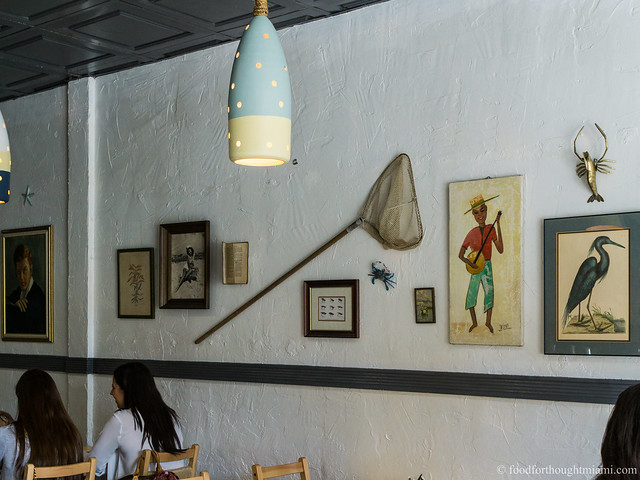 |
| Shelley's - dining room |
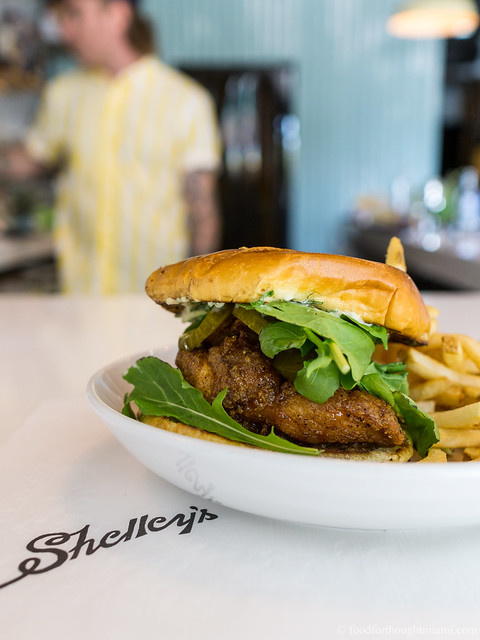 |
| fried chicken sandwich |
 |
| shrimp Scotch egg, grits, kimchi collard greens |
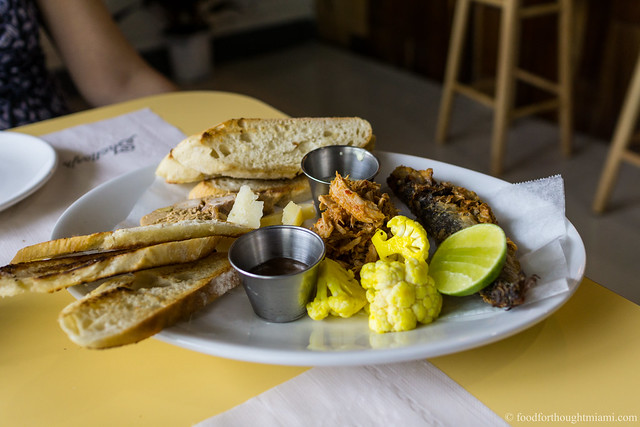 |
| seafood charcuterie platter |
Friday, January 12, 2018
best dishes of 2017: part 3
We left off Part 2 of my "Best Dishes of 2017" (you can see Part 1 here too) in San Francisco. We stay in the Bay Area for Part 3 here, with a trip up to Healdsburg, then detour to Las Vegas, swing back to the east coast for a quick trip to Boston, then back home before ending the year in Santa Fe, New Mexico. As always, the "best" here is meaningless – this is just a compilation of some personal favorites from among several great meals over the course of the year.
Our summer getaway found us on the West Coast, a trip which included a couple days in Healdsburg. The wine country in the northern reaches of Sonoma County is among my favorite places on earth, and now it has a restaurant to match the beauty and bounty of the area: Kyle Connaughton's SingleThread (see more pictures in this SingleThread Farm flickr set). SingleThread is about as fully realized a vision of the Japanese combination of kaiseki dining and ryokan as you'll find outside of Japan: a restaurant, supplied by its own nearby five-acre farm (run by spouse Katina Connaughton) plus contributions from neighboring farmers, fishermen and foragers, with a small, luxurious inn on premises (we regretfully didn’t stay at the inn, instead renting a house up the Russian River so we had room for the whole family and some friends).
This was, from start to finish, just a magical meal – refined and beautiful and flavorful, intimately expressive of season and place.
After a glass of bubbly and a platter of snacks on the rooftop garden terrace, we were brought back inside to the dining room and greeted with a spread that could do double duty as a centerpiece. There’s maybe a dozen different items laid out across the table, interspersed among an arrangement of branches and blooms. I won’t try to recount everything here, and in any event the contents vary from day to day and season to season like the "hassun" course of a kaiseki meal, but I particularly recall the cold slivers of geoduck in a neon peach-hued stone fruit gelee; a tart, bright, green tomato gazpacho; a creamy corn panna cotta with an accent mark of fermented cucumber; silky purple baby eggplant agebitashi with a sesame and plum curd; an intensely rich mousse of potato and salt cod; ripe, fat mulberries from nearby Middlteton Farm. And it's all as delicious as it is beautiful.
From an ornate tapestry of dishes to bare-bones simplicity: wild king salmon, caught in Half Moon Bay, smoked in an ibushi-gin (a type of donabe, or Japanese stone pot, which are something of an obsession at SingleThread), swimming in a vinaigrette of negi (Japanese scallion) bolstered with the magic of shio koji, garnished with a dollop of char roe and a tiara of finely slivered myoga (young ginger) and radish. When I had the smoked salmon at Willows Inn, I was pretty certain that would be the best salmon I'd ever eat in my life. Now I'm not so sure.
So often, foie gras gets fruity accompaniments as a foil for its richness. Here, instead, Connaughton goes vegetal. A disk of poached foie, with a texture like cool butter, is awash in a "tea" of last year's tomatoes, plus an assortment of radishes and their greens in various forms: fresh, preserved, dried. The peppery crunch of the radishes does the same job without the usual cloying sweetness. And then another bit of magic comes from an aged sake poured with it – again, a far cry from the customary sweet Sauternes – which magically pulls it all together, one of the most memorable pairings of the whole year.
I know, we're four deep into this list and we're still haven't left SingleThread. What can I say, it was pretty good. This bowl of Sonoma grains, bound in a luminous green nettle purée, garnished with kasuzuke pickled vegetables, a farro verde beignet, a bouquet of herbs, sprouts and petals from the garden, and a tableside drizzle of an intense aged rib cap jus (presumably a byproduct of the American wagyu served in the prior course), was served as the final savory item on the menu, in the same fashion that a rice dish usually acts as the anchor of a Japanese meal. It was incredibly gratifying and delicious, and felt like something of a summary and recapitulation of all that preceded it.
In October, a conference brought me to Las Vegas, where I always find time to visit Aburiya Raku (read my thoughts and see more pictures in this Aburiya Raku flickr set). It's the first place I tried fresh, house-made tofu and it's still one of my favorite places to order it. The pro move is to go half-and-half: a half order of the "Raku's tofu," served cold with garnishes of katsuobushi, chopped chives, minced ginger, and green tea salt; and a half-order of the agedashi tofu, fried, doused in an enriched dashi broth bobbing with little mushrooms, and topped with a dollop of ikura, shredded nori and more chopped chives. It's so good.
(continued ...)
 |
| mid summer in Sonoma - SingleThread |
This was, from start to finish, just a magical meal – refined and beautiful and flavorful, intimately expressive of season and place.
After a glass of bubbly and a platter of snacks on the rooftop garden terrace, we were brought back inside to the dining room and greeted with a spread that could do double duty as a centerpiece. There’s maybe a dozen different items laid out across the table, interspersed among an arrangement of branches and blooms. I won’t try to recount everything here, and in any event the contents vary from day to day and season to season like the "hassun" course of a kaiseki meal, but I particularly recall the cold slivers of geoduck in a neon peach-hued stone fruit gelee; a tart, bright, green tomato gazpacho; a creamy corn panna cotta with an accent mark of fermented cucumber; silky purple baby eggplant agebitashi with a sesame and plum curd; an intensely rich mousse of potato and salt cod; ripe, fat mulberries from nearby Middlteton Farm. And it's all as delicious as it is beautiful.
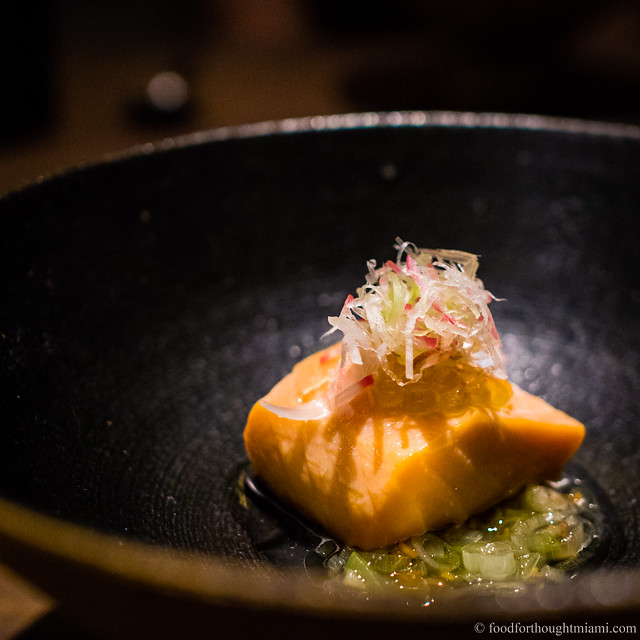 |
| wild king salmon ibushi-gin - SingleThread |
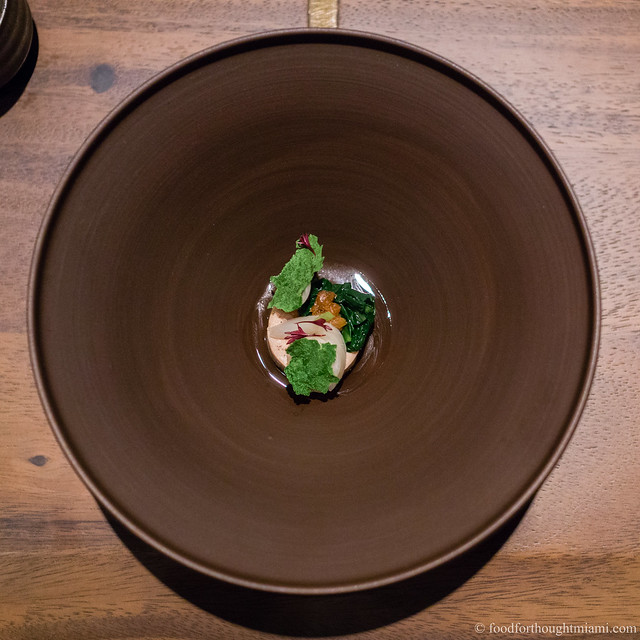 |
| poached foie gras, tea of last year's tomatoes - SingleThread |
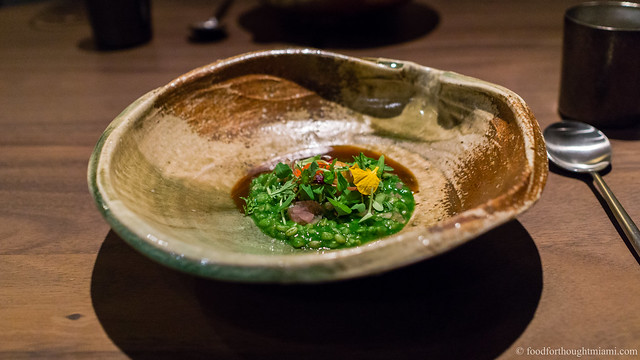 |
| Sonoma grains, nettles, kasuzuke - SingleThread |
 |
| agedashi tofu - Aburiya Raku |
(continued ...)
Monday, January 8, 2018
best dishes of 2017: part 2
We started last Friday with my "best dishes of 2017: part 1" – a compendium of personal favorites from the past year. We resume here with a highly pedigreed fried chicken sandwich, take quick treks through New York and Philadelphia, then detour back to Miami before swinging out to the west coast.
La Pollita was a short-lived Mexican-themed pop-up run from a trailer in the Midtown Garden Center by Luciana Giangrandi and Alex Meyer, who had previously worked at such places as Eleven Madison Park, NoMad, Scarpetta and Animal (read my thoughts and see more pictures in this La Pollita flickr set). The trailer is gone but the duo still seem to be kicking around Miami – I'm looking forward to what's next from them.
They've got a short list of tacos, served on fresh tortillas pressed from masa supplied by Miami masa maestro Steve Santana (of Taquiza), and the cochinita pibil I tried was very good. But the standout item was the fried chicken cemita. A hot, crispy, juicy tranche of fried chicken. A crunchy, vinegar-laced, herb-flecked cabbage slaw. A dollop of mashed avocado for some richness. A creamy, mildly spicy Valentina aioli. A sesame-seed flecked bun with just the right heft: substantial enough to be a meaningful component of the sandwich composition and to keep everything together until the last bite; but not so much as to overwhelm the stars of the show. It is just about perfect.
Hey, look, it's another great meal I never got around to writing about, at David Chang's Momofuku Ko, where the kitchen is run by Sean Gray (see more pictures in this Momofuku Ko flickr set). I never got to the original incarnation of Ko, legendary for its relatively affordable tasting menus, brutally uncomfortable stools, and impossible reservation system. In its newer digs down a tiny East Village street literally called "Extra Place," it retains some of its original punk sensibilities – the dining counter circling an open kitchen, the cooks presenting the dishes, the hip-hop soundtrack – but it's all pretty buffed and polished, kind of like a Gucci biker jacket.
The tasting menu still carries a couple of the original Ko classics – the "Ko egg" with caviar, crispy potatoes, onion soubise and sweet potato vinegar, the shaved frozen foie gras – but one of my favorites of the evening was a next generation Ko dish. It's deceptively simple: lobes of cold, sweet sea urchin, a scoop of chickpea hozon (a creamy, miso-like fermented paste), a drizzle of grassy olive oil. There's a subtle contrast of marine salty-sweet against earthy salty-sweet; of the delicately creamy texture of the uni against the thicker, peanut butter-y hozon, mirrored by the two orange shades on the plate. Pretty cool.
Another of my favorites at Ko was another deceptively simple composition: a dessert of cherry blossom dusted ice cream, served over creamy, sweet amazake (rice fermented with sake lees or koji), drizzled with a sauce of preserved cherries. It was simultaneously delicate but powerful, homey but elegant.
Olmsted, Greg Baxtrom's Brooklyn restaurant with a backyard garden that does double-duty as a pre- and post-meal hangout spot, has been much talked about (see more pictures in this Olmsted flickr set). In a way, all the chatter possibly sets expectations a bit too high, for what is just a really fun, delicious, casual, cozy, clever, relatively affordable neighborhood spot run by someone with chops honed at Alinea, Blue Hill at Stone Barns, Per Se, and Arzak. The menu changes all the time – they were on a yakitori bender during our visit, while also serving Hyderabadi inspired duck chakna, truffle-dusted rutabaga "tagliatelle," and simple but delicious sauteed soft-shell crab with pickled peppers and ranch dressing – but this one dish seems to have become a signature, and for good reason. A goldenrod hued carrot crepe serves as the platform for a salad of wispy slivers of multi-colored carrots, petals, sprouts, and sunflower seeds, concealing a rich clam and carrot stew underneath. It's unusual, unexpected, and delicious.
Daniel Rose's path was a somewhat unusual one. The Chicago native was inspired to move to Lyon to study cooking after taking classes at the American University in Paris. After years at the Institut Bocuse and apprenticeships around France, he opened his first restaurant – Spring – in Paris. It wasn't until a decade later that he returned to the States to open Le Coucou in New York with Stephen Starr (see more pictures in this Le Coucou flickr set). In a way, the place makes it feel like the last couple decades of dining history never happened. There are pressed white tablecloths and long wax tapers on the tables; the menu isn't a collage of small plates, but good old fashioned hors d'oeuvres, poissons et viandes (though a category of "gourmandises" features otherwise uncategorized indulgences like quennelles de brochet and veal tongue with caviar).
But the cooking is more precise, focused, bright and clean than the butter and cream laden juggernauts of the older era that Le Coucou otherwise invokes. And nowhere was that more evident than in a dish called "tout le lapin" (all the rabbit), a production which comes to the table in three different serving vessels (the picture here is better focused, but this one gives a view of the whole spread). The saddle is rolled and cooked and then sliced into rounds which are seared and browned, then napped with a loose sauce that takes the ferrous richness of rabbit offal, cuts it with an acidic vinaigrette, and brightens it with fresh mint. Alongside is a gratin dish of the rabbit's legs cooked down with soft, sweet onions. And finally, a pot au feu of the foreleg, in a golden broth bobbing with carrots and turnips. It's all wonderful.
(continued ...)
 |
| fried chicken cemita - La Pollita |
They've got a short list of tacos, served on fresh tortillas pressed from masa supplied by Miami masa maestro Steve Santana (of Taquiza), and the cochinita pibil I tried was very good. But the standout item was the fried chicken cemita. A hot, crispy, juicy tranche of fried chicken. A crunchy, vinegar-laced, herb-flecked cabbage slaw. A dollop of mashed avocado for some richness. A creamy, mildly spicy Valentina aioli. A sesame-seed flecked bun with just the right heft: substantial enough to be a meaningful component of the sandwich composition and to keep everything together until the last bite; but not so much as to overwhelm the stars of the show. It is just about perfect.
 |
| sea urchin, chickpea hozon - Momofuku Ko |
The tasting menu still carries a couple of the original Ko classics – the "Ko egg" with caviar, crispy potatoes, onion soubise and sweet potato vinegar, the shaved frozen foie gras – but one of my favorites of the evening was a next generation Ko dish. It's deceptively simple: lobes of cold, sweet sea urchin, a scoop of chickpea hozon (a creamy, miso-like fermented paste), a drizzle of grassy olive oil. There's a subtle contrast of marine salty-sweet against earthy salty-sweet; of the delicately creamy texture of the uni against the thicker, peanut butter-y hozon, mirrored by the two orange shades on the plate. Pretty cool.
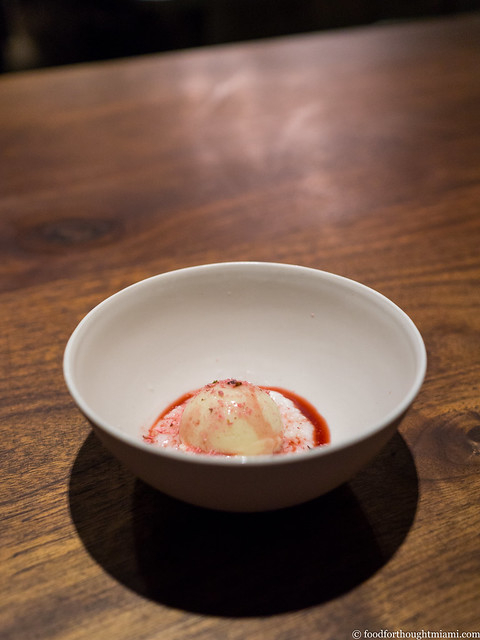 |
| cherry blossom, amazake - Momofuku Ko |
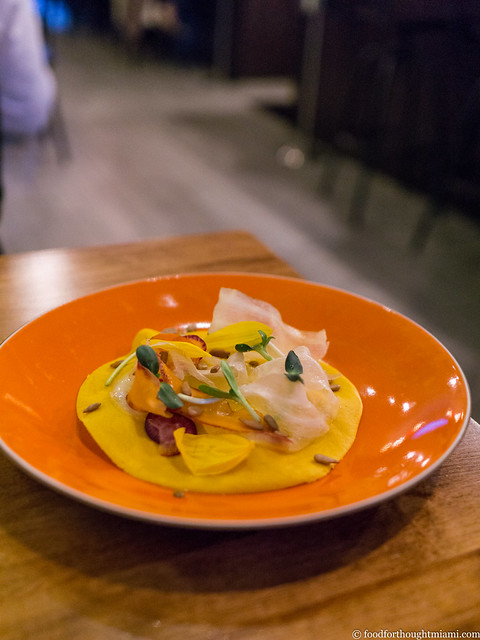 |
| carrot crepe, littleneck clam, sunflower - Olmsted |
 |
| tout le lapin - Le Coucou |
But the cooking is more precise, focused, bright and clean than the butter and cream laden juggernauts of the older era that Le Coucou otherwise invokes. And nowhere was that more evident than in a dish called "tout le lapin" (all the rabbit), a production which comes to the table in three different serving vessels (the picture here is better focused, but this one gives a view of the whole spread). The saddle is rolled and cooked and then sliced into rounds which are seared and browned, then napped with a loose sauce that takes the ferrous richness of rabbit offal, cuts it with an acidic vinaigrette, and brightens it with fresh mint. Alongside is a gratin dish of the rabbit's legs cooked down with soft, sweet onions. And finally, a pot au feu of the foreleg, in a golden broth bobbing with carrots and turnips. It's all wonderful.
(continued ...)
Friday, January 5, 2018
best dishes of 2017: part 1
I know, I know, you're supposed to do these "best of the year" wrap-ups before the year actually ends. Well, I'm just glad we've made it through to 2018, so I'm not going to sweat the timing all that much. Looking back, it was a somewhat odd year of eating for me. We traveled – London, Paris, New York, Philadelphia, Chicago, Boston, San Francisco, Las Vegas, Santa Fe – but they were all mostly short jaunts, a few days here and there that were over almost as soon as they began. Meanwhile, I'm feeling increasingly out of touch with developments here at home; the list of new Miami restaurants I haven't yet tried grows longer and longer.
Sometimes that's purposeful: just because it's new doesn't necessarily mean it's interesting or good. Sometimes it's geographically driven: one of the more interesting phenomena of the past year, to me anyway, is the abundance of independent restaurants opening outside of the usual trifecta of Wynwood, South Beach and Brickell. I'm thinking of places like Ghee in Downtown Dadeland, No Name Chinese and Shelley's in South Miami, Doce Provisions and Ella's Oyster Bar in Little Havana, Sherwood's Bistro in Little Haiti, Finka Table and Tap and Amelia's 1931 out west. Some of those are easier for me to get to than others, but those I've gotten to have provided some of the most interesting eating of the past year. And sometimes, let's be honest, inertia sets in.
As always, despite that word "best," I make no pretense of this being any sort of objective listing, only my personal favorites of the places I had the good fortune to visit in 2017. They are not ranked, but rather are listed here in roughly chronological order. For ease of digestion, I'll be breaking this up into three parts.
I wasn't sure Miami needed a second Bazaar restaurant from Chef José Andrés, but I'm glad we got another, and the seafood-focused menu at Bazaar Mar is sufficiently different from the original that they're both worthy of a visit (you can read my thoughts and see more pictures in this Bazaar Mar flickr set). There are lots of flashy, showy dishes there, but one of my favorites was one of the simplest.
The larger dishes on the menu tend to skew a bit more traditional, but that doesn't necessarily mean boring. I loved these little cockles, fresh from the tank, in a Basque-style pil pil sauce, an emulsion of garlic, parsley, olive oil and fish juices.
José Andrés' accomplishments this past year far transcend the restaurant world: through World Central Kitchen, he delivered over two million meals to over seventy locations in Puerto Rico after Hurricane Maria devastated the island. He also continues to run restaurants that make some great food. José for President!
Chef Niven Patel of Ghee is making some of the most exciting food in Miami right now, and over the past year he's gone from doing pop-ups at his home in Homestead to opening two restaurants featuring his version of farm-to-table Indian cuisine. We got a taste back in March, shortly before his first spot in Downtown Dadeland opened (read my thoughts on our Cobaya Rancho Patel dinner and see more pictures in this Cobaya Rancho Patel flickr set).
A special treat: khandvi, or as our menu called them, "chickpea roll-ups." This was something I'd never tried before, and for good reason: Niven says you're unlikely to ever see these unless your mother or grandmother is making them, as getting the batter – a mixture of chickpea flour and yogurt or buttermilk – and texture right is a bit of alchemy that could keep molecular gastronomists busy for a while. I was glad someone knew how to do it: these light, fluffy crepes, reminiscent of Japanese tamagoyaki, and seasoned with toasted black mustard seeds, julienned cilantro and curry leaf, were absolutely delicious.
February featured a whirlwind trip to London and Paris, three days in each, which included a visit to one of the culinary stations of the cross: Fergus Henderson's St. John restaurant (actually, its sibling, St. John Bread and Wine in Spitalfields) (read my thoughts and see more pictures in this St. John Bread and Wine flickr set).
Of course, you have to start with the roasted marrow bones – Henderson's most famous dish, one that has been lovingly duplicated countless times in countless restaurants around the world, one that Anthony Bourdain declared his "always and forever choice" for his Death Row meal. The formula is now well-known: roasted femur bones; toasted bread; a pile of parsley salad; a mound of coarse sea salt. Scoop the oozy marrow from the bone, spread on to the toast, dress with a sprinkle of salt and a pinch of the salad, and enjoy. I've had it dozens of times, but never until now the original. And yes, it's the best: the marrow at the magic borderline between solid and liquid, the acid and salt and herbaceous bite of the salad right on the edge of too aggressive without crossing the line, with just the right punch of caper and shallot. I can't say it better than Fergus himself:
Our dinner at The Clove Club, chef Isaac McHale's all-grown-up supper club in Shoreditch, was one of my favorites of the year; two dishes from that meal appear here (read my thoughts and see more pictures in this Clove Club flickr set).
In "The Physiology of Taste," Brillat-Savarin famously wrote, "The discovery of a new dish confers more happiness on humanity than the discovery of a new star." I can't say for certain that this is an entirely new dish; I can say it's the first time I've had this particular combination of raw scallop, slivered raw button mushrooms, crushed hazelnuts, clementine and black truffle, all assembled over a jet-black squid ink purée. The scallop itself – from fisheries in Orkney, in the outer northern reaches of Scotland – is beautifully plump and fresh and sweet. It's complemented by a fascinating interplay of earthy and nutty flavors, brightened just a hint by the citrus. Speaking for myself, anyway, it's a lot more exciting than the latest "cold brown dwarf."
Tasting menus often tend to peter out (for me anyway) as you approach the "big protein" stage, with creativity and finesse giving way to a push for satiety. Not here. This rabbit dish is a tour de force, making use of all the animal in a variety of ways – a ballotine threaded with green leaves, a pinkish slice of loin, tiny chops from the ribs, a wee rabbit heart, a cromesqui of offal, pulled together with a bright green herb sauce redolent with tarragon, then finally drizzled tableside with a rabbit broth. Fantastic.
(continued ...)
Sometimes that's purposeful: just because it's new doesn't necessarily mean it's interesting or good. Sometimes it's geographically driven: one of the more interesting phenomena of the past year, to me anyway, is the abundance of independent restaurants opening outside of the usual trifecta of Wynwood, South Beach and Brickell. I'm thinking of places like Ghee in Downtown Dadeland, No Name Chinese and Shelley's in South Miami, Doce Provisions and Ella's Oyster Bar in Little Havana, Sherwood's Bistro in Little Haiti, Finka Table and Tap and Amelia's 1931 out west. Some of those are easier for me to get to than others, but those I've gotten to have provided some of the most interesting eating of the past year. And sometimes, let's be honest, inertia sets in.
As always, despite that word "best," I make no pretense of this being any sort of objective listing, only my personal favorites of the places I had the good fortune to visit in 2017. They are not ranked, but rather are listed here in roughly chronological order. For ease of digestion, I'll be breaking this up into three parts.
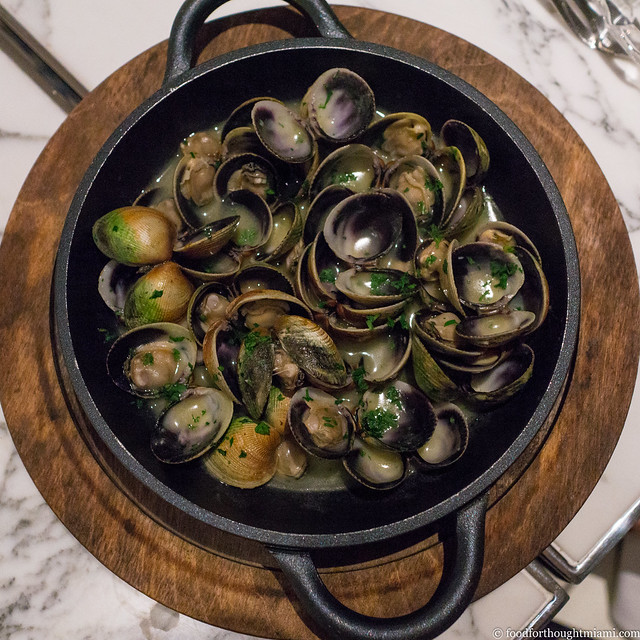 |
| cockles, pil pil sauce - Bazaar Mar |
The larger dishes on the menu tend to skew a bit more traditional, but that doesn't necessarily mean boring. I loved these little cockles, fresh from the tank, in a Basque-style pil pil sauce, an emulsion of garlic, parsley, olive oil and fish juices.
José Andrés' accomplishments this past year far transcend the restaurant world: through World Central Kitchen, he delivered over two million meals to over seventy locations in Puerto Rico after Hurricane Maria devastated the island. He also continues to run restaurants that make some great food. José for President!
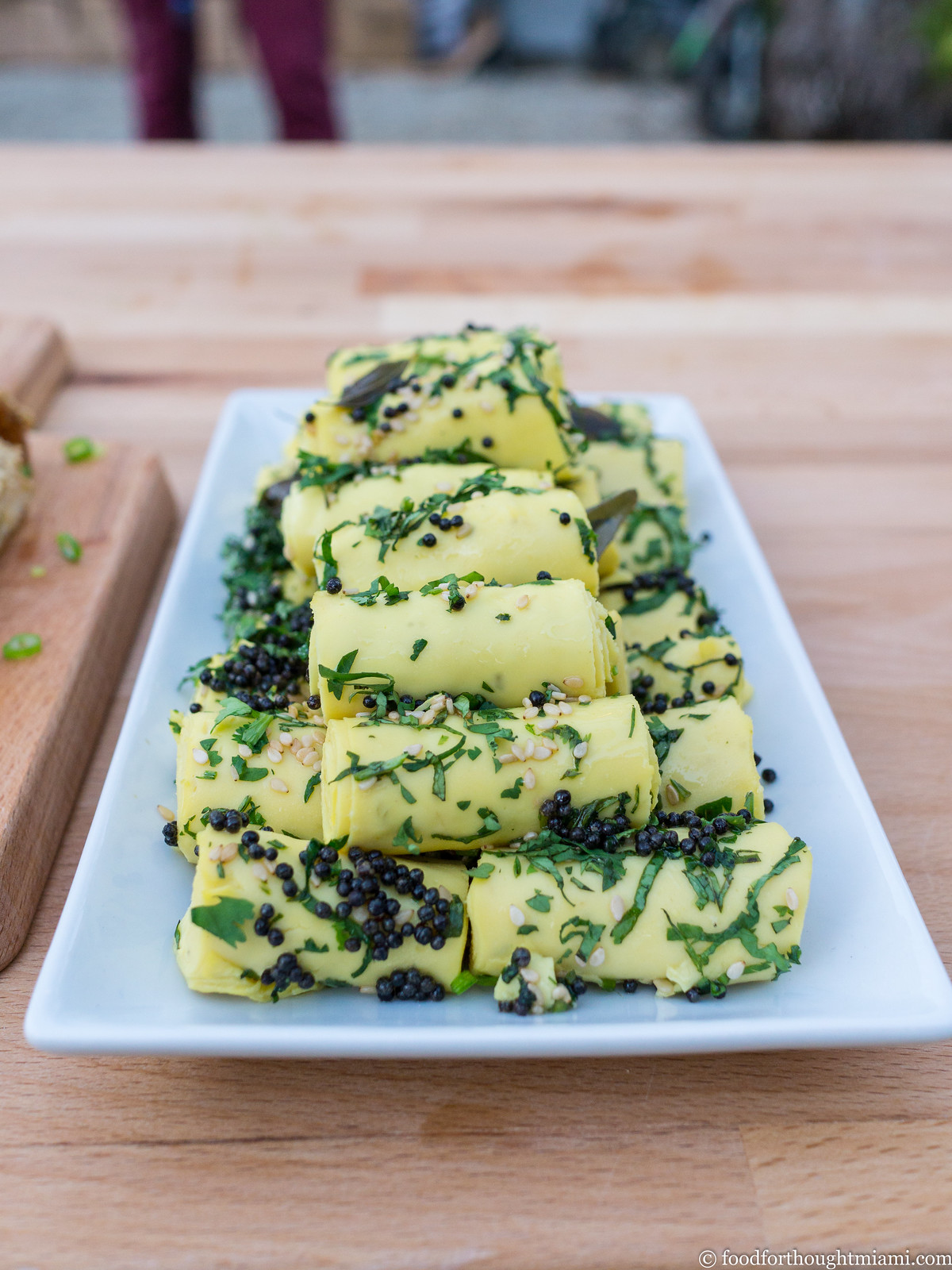 |
| khandvi - Ghee Rancho Patel Cobaya dinner |
A special treat: khandvi, or as our menu called them, "chickpea roll-ups." This was something I'd never tried before, and for good reason: Niven says you're unlikely to ever see these unless your mother or grandmother is making them, as getting the batter – a mixture of chickpea flour and yogurt or buttermilk – and texture right is a bit of alchemy that could keep molecular gastronomists busy for a while. I was glad someone knew how to do it: these light, fluffy crepes, reminiscent of Japanese tamagoyaki, and seasoned with toasted black mustard seeds, julienned cilantro and curry leaf, were absolutely delicious.
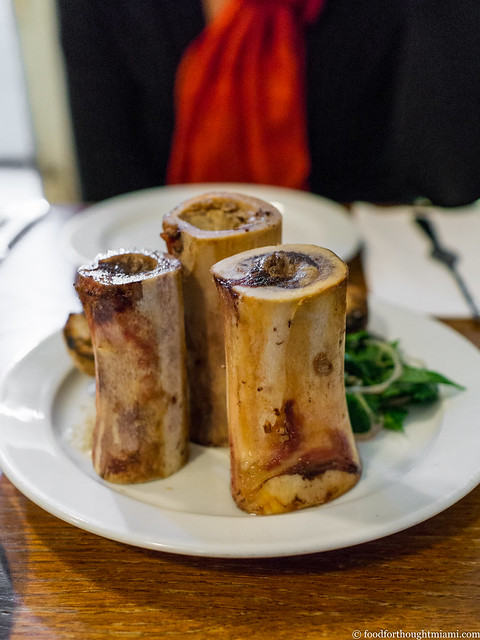 |
| roast bone marrow - St. John Bread and Wine |
Of course, you have to start with the roasted marrow bones – Henderson's most famous dish, one that has been lovingly duplicated countless times in countless restaurants around the world, one that Anthony Bourdain declared his "always and forever choice" for his Death Row meal. The formula is now well-known: roasted femur bones; toasted bread; a pile of parsley salad; a mound of coarse sea salt. Scoop the oozy marrow from the bone, spread on to the toast, dress with a sprinkle of salt and a pinch of the salad, and enjoy. I've had it dozens of times, but never until now the original. And yes, it's the best: the marrow at the magic borderline between solid and liquid, the acid and salt and herbaceous bite of the salad right on the edge of too aggressive without crossing the line, with just the right punch of caper and shallot. I can't say it better than Fergus himself:
"Do you recall eating Raisin Bran for breakfast? The raisin-to-bran-flake ratio was always a huge anxiety, to a point, sometimes, that one was tempted to add extra raisins, which inevitably resulted in too many raisins, and one lost that pleasure of discovering the occasional sweet chewiness in contrast to the branny crunch. When administering such things as capers, it is very good to remember Raisin Bran."
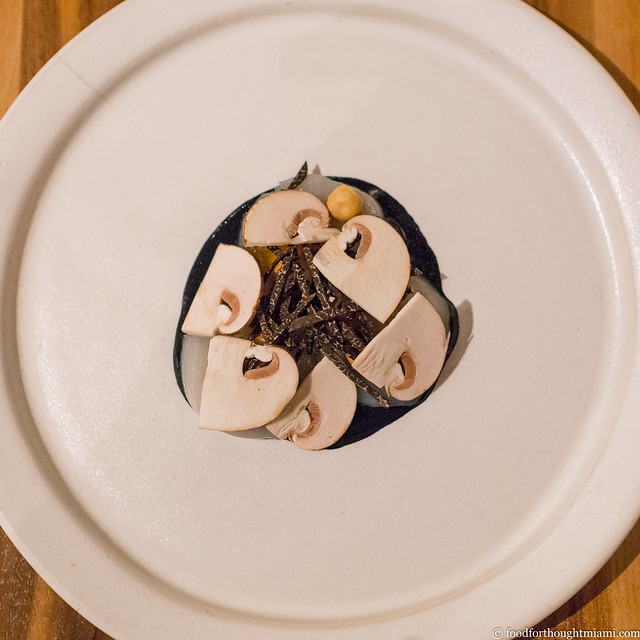 |
| raw Orkney scallop, hazelnut, clementine, winter truffle - The Clove Club |
In "The Physiology of Taste," Brillat-Savarin famously wrote, "The discovery of a new dish confers more happiness on humanity than the discovery of a new star." I can't say for certain that this is an entirely new dish; I can say it's the first time I've had this particular combination of raw scallop, slivered raw button mushrooms, crushed hazelnuts, clementine and black truffle, all assembled over a jet-black squid ink purée. The scallop itself – from fisheries in Orkney, in the outer northern reaches of Scotland – is beautifully plump and fresh and sweet. It's complemented by a fascinating interplay of earthy and nutty flavors, brightened just a hint by the citrus. Speaking for myself, anyway, it's a lot more exciting than the latest "cold brown dwarf."
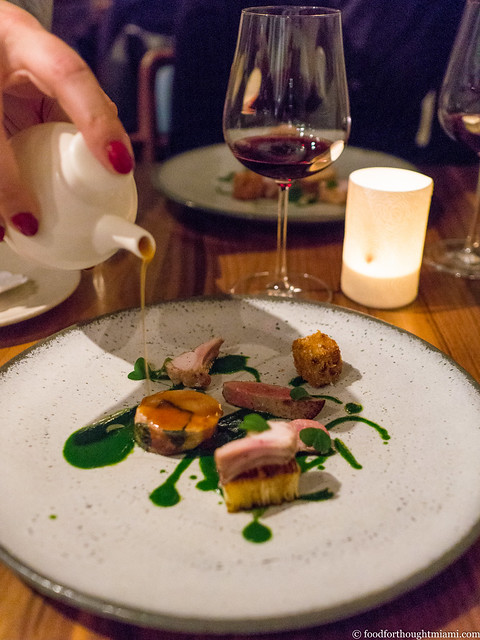 |
| rabbit, celeriac, smoked bacon, tarragon - The Clove Club |
(continued ...)
Tuesday, January 2, 2018
best thing i ate last week: green chile dosa at Paper Dosa in Santa Fe
One of my New Year's resolutions: post more frequently. So let's start 2018 on the right foot by getting back to these "best thing I ate last week" posts - a nice way to keep current without doing the usual more lengthy exegesis (and fewer footnotes!).
We just spent a few days between Christmas and New Year's Eve in Santa Fe, a place with some great food traditions which bridge Mexico and New Mexico, in much the same way that Tex-Mex has become its own particular idiom. One of the challenges I always face when choosing where to eat in these types of communities is how closely to hew to tradition, particularly with limited dining opportunities. Do I look for the most "authentic" places (whatever that means), or do I just look for good food?
I went in the latter direction for our last night in Santa Fe, and it worked out great. Paper Dosa (see more pictures in this Paper Dosa flickr set) is a South Indian place run by chef Paulraj Karuppasamy which began as a catering business, then started doing weekly pop-up dinners, and in 2015 opened as a full-blown restaurant. The menu features about a half-dozen appetizers and chaats, several choices of dosas and uttapam, rounded out with a few curries. It reminds me quite a bit of Hopper's in London, where we had a great lunch early last year.
Everything at Paper Dosa was eye-poppingly good, but the standout was a dish that sort of came full circle: a delicate dosa (a crepe made of fermented rice and lentil batter) stuffed with local green chiles and melted cheese, served with traditional accompaniments of sambar (a sort of lentil stew), plus coconut and tomato chutneys. This wasn't one of those goofy "fusion" dishes, like where some French or Italian dish gets some incongruous Asian ingredient thrown into it. It tasted entirely South Indian, and entirely New Mexican, all at once. And it was the best thing I ate last week.
Happy New Year, all, and welcome to 2018.
Paper Dosa
551 W. Cordova Road, Santa Fe, New Mexico
505.930.5521
Subscribe to:
Posts (Atom)


